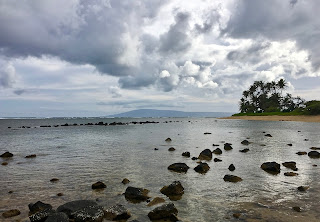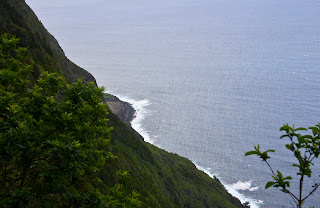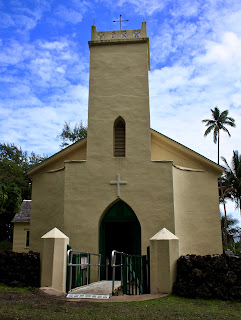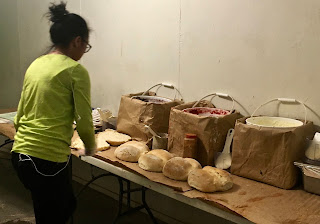I think my first awareness of the Hawaiian island of Molokai, the one used to locate a leper colony, came from my mother. She taught school on the island of Kauai in the early 1950s, and that colony, situated on the isolated Kalaupapa Peninsula from 1866-1969, was still in existence. My childhood memories are layered with songs and hula and stories and muumuus and leis from my mother's experiences in Hawaii. Molokai never headlined the Hawaiian moments she shared with her children, but I know it showed up a few times--maybe as an extension to a discussion of leprosy and lepers, one generated in reference to a scripture story we were reading as a family.
As an adult, my friend Tammy reconnected me to Molokai when she told me the story of Father Damien. On Netflix I found the 1999 movie, Molokai: The Story of Father Damien, based on Damien's experiences in Molokai. I watched it, transfixed--probably more for story than for cinema greatness, but the story moves me. You can watch the movie yourself, now on YouTube in its entirety, right here. (I know because I recently watched the movie again, this time on YouTube!)
When Tammy and I visited Hawaii around five years ago, we considered a quick jaunt to Molokai from Maui but couldn't make the side trip work with the rest of our vacation schedule. When I moved to Hawaii, a visit to the island of Molokai remained high on the list in my mind of places to go. Finally last month--March--my friend Camille and I met in Honolulu and took the quick flight to Molokai--ascend, down a quick drink, descend--on a small turbo prop that shuddered and bounced in the wind on its descent!
Molokai, Hawaii's fifth largest island, is 38 miles long and 10 miles across at its widest. With a little over 7,000 residents, many of them native Hawaiians, it has a rural vibe and a more traditional Hawaiian sensibility.
Once we arrived at the Molokai Airport just after the noon hour on a Friday, we picked up a rental car and lunched at a hamburger joint before heading to our vacation rental. Then, with drive-by reconnaissance of much of the island and a few stops at various beaches--all pretty and mostly bereft of other humans--we whiled away the afternoon.
Although we had changed into our swimsuits in preparation for some beach time, the gusty day proved to be a bit chilly for any water play. We stocked up on breakfast items in Kuanakakai--the largest town, the hub of civilization on the island--ate dinner at Paddler's Restaurant and Bar, and returned to our vacation rental to prepare for Saturday's adventure: a mule ride down and up the highest sea cliffs in the world and a tour of the former leper colony in Kalaupapa.
Kalaupapa is isolated--maybe its foremost characteristic and the one that led to its designation in 1866 as the site for a leper colony. Virtually barricaded from the rest of the island by the highest sea cliffs in the world, the sea became its main access, but an access that could be dictated by those with the power and the wealth to accomplish it...or not. A steep, winding path, a little over three miles long, does exist on a portion of the expanse of sea cliffs, a path that can be hiked or done riding a mule. The hike is ranked as 4 out of 5 in difficulty, with 5 as the greatest amount of difficulty. Camille and I opted for the mule ride.
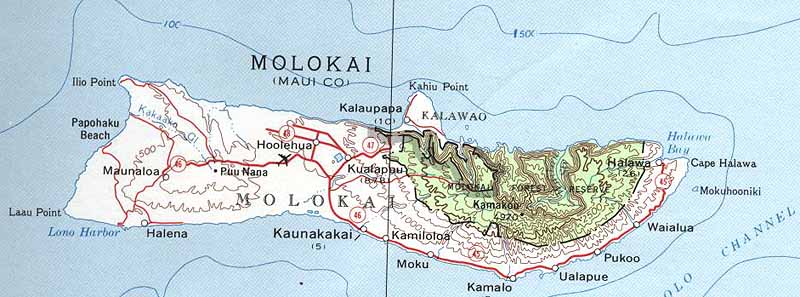
(Kalaupapa now has a tiny airport, too, so tourists can also arrive via air; tourists--and the number per day is limited--arrive on foot, on mule, or by plane. Nowadays a barge carries the "big" supplies to Kalaupapa once or twice a year; otherwise, supplies come via small plane or else by the physical effort of human or beast.)
With a 7:45am check-in for the mule ride, Camille and I arrived early on Saturday morning. Our two muleskinner guides matched the six tourists (yep, that's all because two mules were on loan to a movie set, so really the biggest number of tourists possible per day on the mule ride could be eight) with their mules and briefed them on mule-riding protocol. We did practice how to "control" our mules a bit before commencing the trek.
The trek down was difficult, often uncomfortable on the body, stressful at moments, and absolutely amazing. Deuce liked to eat, and the two of us ultimately reached a viable working relationship--how to balance a time to chew and a time to move forward, especially once I realized which of the other mules provoked Deuce's competitive nature. The trek back up was much easier and faster, too! These next photos are from the trek itself, most of them from the ascent because taking pictures becomes so much easier when one doesn't have to constantly engage preventative measures to avoid a tumble over the head of one's mule.
The tour of the former leper colony and the current community on Kalaupapa was both fascinating and moving. Our guide had a personal connection to the community and a spiritual one, too, I think. In fact, he and his brother show up briefly in that 1999 movie. (The movie actually incorporated many members from the Kalaupapa community.) Funny and a great storyteller, his emotions hovered on the surface of all he shared and touched the hearts of his listeners.
These photos are from the tour of the former leper colony and the current Kalaupapa community.
Saturday evening, after showers and dinner, Camille and I decided to participate in Molokai's hot bread run. Yeah, that's a major thing in the Molokai nightlife scene! On an island where only two or three establishments have liquor licenses, legend has it that Kanemitsu's began as a bar and solved its problem of drunk patrons hanging around all night by serving hot bread to soak up all the ingested alcohol. The bar eventually evolved into Kanemitsu Bakery, and now around 8:00 most nights the bakery sells hot bread with toppings to locals and tourists in-the-know. However, the night-time hot bread is not purchased inside the bakery per se. Instead, you wander down this dark alley at the side of the bakery--definitely seedy in aura and portending great danger...except this is Molokai!--until you find this:
At the back of the corridor is a window where you place orders and pay up.

The bread is served hot, fresh from the oven, as an entire loaf sliced horizontally through the middle and slathered with desired topping or a combination thereof: butter, cream cheese, cinnamon, blueberry jam, and strawberry jam.
Camille and I ordered one with butter and cinnamon--warm, sweet, and a total carb overload! We didn't even consume half the loaf but concluded that if ever there were a second Molokai hot bread run in our lives, we would order one with butter, cinnamon, and cream cheese!
Sunday, before our afternoon departure for Honolulu, we undertook a bit more drive-by exploration of the island. On a deserted highway with a sea-facing approach we observed two humpback whales frolicking off-shore--a splendid image for memories of an ending.




